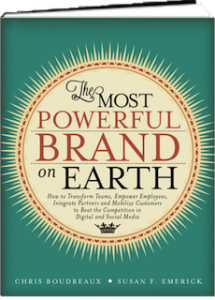Want to Improve Your Business Storytelling? Here are Seven Ways to Raise Your Game in 2016
I am super passionate about what I do in the world of telling business and marketing stories. If you read my stuff and know me – you know I am a storytelling nerd (from the business and improv stages). Proudly!
I love that that storytelling is experiencing a ‘corporate Renaissance’ across business, social media, social entrepreneurship, executive communications – you name it. Storytelling is so much bigger than marketing. It’s the foundation of how companies communicate who they are in the world and what they stand for. A resurgence is a great thing and storytelling itself – the oldest and original social medium for humans – is evolving in the business world. That is a great thing.
In doing my work, in chatting with fellow story practitioners and branding execs working within companies, and in doing research for a book to be published later this year, here is what I believe (and am already experiencing) the next wave of storytelling will look like, and much of it involves getting out of the way, empowering others, and thinking bigger. Here are seven ways to reinvigorate your organization’s storytelling for more successful marketing this year:
1. Many of today’s business stories are “storytelling lite.” Your storytelling must go deeper to be more effective. Most brand storytelling today is superficial and still too ‘corporate’ oriented – rather than aimed at human needs. Future business storytelling that is successful and sustainable must go deeper. It needs to get vulnerable, real, and drop the perfect ‘resolution’ ending – because that makes for crappy stories. Sometimes stories are imperfect – like people – and that’s OK. In fact, it’s great because it’s real. We’ll see more brands and companies getting real and vulnerable – and that’s a great thing! A deeper emotional connection gives a story legs.
2. Storytelling will have more of a ‘social change’ component. This is is already happening (consider TOMS, Patagonia, even IBM’s Smarter Planet for b2b), it’s and something I have written about over the years as I have always believed storytelling must be bigger than the company.
In part, though not exclusively, this is a generational change. Millennials especially want to do business with companies that care – thankfully – about causes bigger than themselves. And most humans do – not just Millennials. It matters. People make choices based on social issues and so companies need to not only give a crap about customers, they need to tell transparent stories about their mission and how that affects society, not just customers’ economic situations. Companies kicking butt here include Warby Parker, Lyft, and The Humane Society to name a few organizations. This isn’t about creating something fake just to check a box; it’s making sure your mission is alignment with a core purpose that is bigger than your company. Great businesses, thankfully, are always about far more than profits. And it’s time to communicate that authentically through “prove it” stories.
3. The ‘Corporate Veil’ is coming down in favor of a human frame.This one is also near and dear to my heart (they all are!). Part of the reason many brand stories fail to capture the imagination today is because they are still oriented around companies as protagonists. Companies can’t be. People don’t care about companies. They care about people. You can’t hug or thank a company – though we all want to slap companies! People can’t seem themselves reflected in a story about a ‘faceless organization.’ That means all great, emotional brand storytelling must be told through the lens of a person -a specific customer, a passionate employee, a dedicated partner. Every great company story must be anchored in a human story – and told through a personal human lens. Anchor your stories through real people and you’ll see a big difference in your storytelling.
4. (Related to number 3) Great storytelling is becoming decentralized inside and outside the organization. In short, story stewardship is every employee’s responsibility; it’s the C-suite’s job to keep the fire lit. The best storytellers are often not in the C-suite. We know from studies like ‘The Edelman Trust Barometer’ that customers trust people like us, and that means employees, not executives or the marketing and PR department. Yes, marketing needs to have a hand in storytelling, but controlling the message and who tells it so closely can destroy value for the company rather than help increase it. The best storytellers are closest to the front lines of service, product, and sales, for example. And unleashing these (trained) storytellers will increase the credibility and scale of your storytelling efforts, and that, as in the case of IBM who measured this over 7 years, is likely to result in increased lifetime customer values. That’s powerful return on investment.
5. Customers will have an increasingly important role in credible storytelling.Smart brands already do this; it’s time for others to step up. Some of the best content today is created or co-created by customers – another important way to engage and scale. Look no further than GoPro for examples of fantastic consumer-generated content. This is an engaging way to scale story and content in a way that is human, real and authentic. Microsoft, too, has also done a great job lately of successful storytelling through the lens of customers.
6. Great B2B Storytelling sells emotional, personal value not just rational value. Emotions matter. This is not new; it’s taken B2B a while to get on board, though. Some of the best storytelling today is still being done by B2C; yet, there is no reason B2B can’t adopt that narrative mentality. Emotional narrative is critical to great storytelling and B2B can learn from Hollywood scriptwriting here. Google and CEB did a joint study a few years back that illustrated the following key finding that I have cited several times in my work: personal value had 2X the weight in a B2B purchase decision as rational economic value did. That means, all buyers are human and ask, ‘How does this make my life better?’ This isn’t just about economic benefit for the company; it’s about solving a human need for the buyer, a person.
7. Storytelling Must Get Rid of the Crappy Endings. A story that ends with an economic benefit makes a really crappy ending. Simply telling your audience that your product will help them save or make money or time—concentrating on a rational, economic benefit—is a really shallow ending because, as mentioned earlier, it has no anchoring in a personal, emotional outcome. “So what?” I say. And so do a lot of your users. Shallow is emotionally unsatisfying. And your competition claims the exact same thing.
What users really want to know is how their personal lives will change. They want hope that they will be better. What will money allow them to do to achieve community, fulfillment, credibility, recognition, and all the things that human beings want? Money is only a means to an end. Find those passions and go there.
Your audience has human needs that have nothing to do with your product or service, and those needs go beyond rational, economic value. It’s your job to find what they are and tell stories that speak emotionally to those needs. Did your product help them reach personal goals? How? Go there! It’s never about your product, ever.
It’s even OK to have a story ending that is open-ended, still evolving, and that leans towards hope. You can also have a business story that invites your audience to co-create an ending for themselves by sharing their stories. TOMS above, for example, invites partners and customers to be a big part of fulfilling its larger mission because the company knows that its role is evolving and that movements never happen without co-creators.
A great ending isn’t perfect, just better. And realistic. That’s simple and honest.
How do you improve your business storytelling? Let me know in the comments below. Would love to hear!






